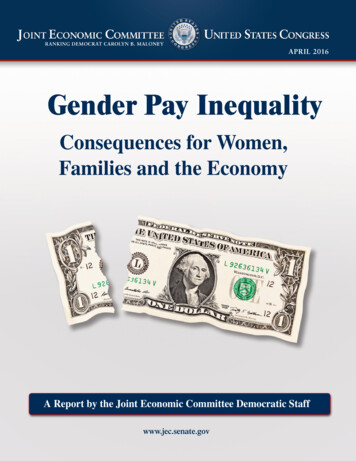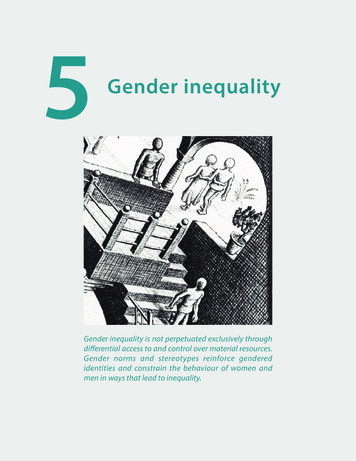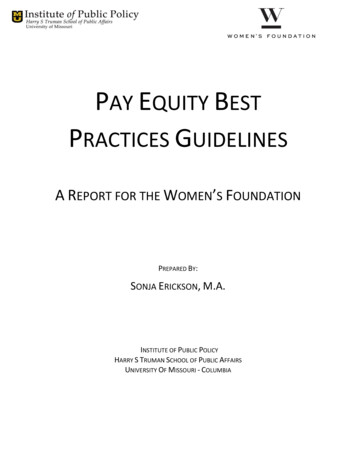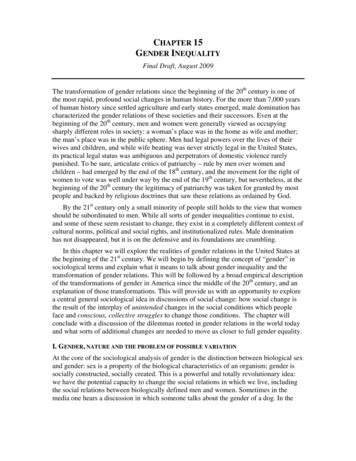
Transcription
APRIL 2016Gender Pay InequalityConsequences for Women,Families and the EconomyA Report by the Joint Economic Committee Democratic Staffwww.jec.senate.gov
This page intentionally left blank
TABLE OF CONTENTSIntroduction. 1The Gender Pay Gap. 2How Economists Calculate the Gender Pay Gap. 2Career-Long Wage Disparities Jeopardize Women’s Retirement Security. 3The Gender Pay Gap Affects What Women Receive From Social Security . 4Women Receive Less Pension Income Than Men . 5A Higher Percentage of Women Live in Poverty After Age 65 . 5Disparities by Race, Age and Region. 6Many Women of Color Face Larger Gender Pay Gaps When Compared to White Men . 6The Disparity Between Male and Female Earnings Increases With Age . 7The Size of the Gender Pay Gap Varies Widely in Different Parts of the Country . 8The Broader Costs of Gender Pay Inequality . 9America’s Families Depend on Women’s Earnings . 9Gender Wage Disparities Hurt the Economy . 11Factors That Contribute to the Gender Pay Gap. 12Women Are More Likely Than Men to Interrupt Their Careers to Care for Children . 12Working Mothers Often Pay a “Mommy Penalty” . 14Women Are More Likely Than Men to be Primary Caregivers of Other Family Members . 14Women Who Are Forced to Work Part Time Earn Less . 15Women Tend to Study in Lower-Paying Fields . 15Women Often Work in Occupations That Pay Less . 17Women Are Underrepresented in Leadership . 19Evidence Suggests That Some Women Still Do Not Receive “Equal Pay for Equal Work” . 20International Comparisons . 20The Gender Pay Gap Is Larger in the United States Than in Many Other Developed Countries . 21The United States Is the Only Advanced Country That Does Not Guarantee Paid MaternityLeave . 22The United States Is One of Only a Few Countries Without A Paid Sick Leave Policy . 23The United States Has the Third Highest Out-of-Pocket Child Care Costs in the OECD . 24Many High-Income Countries Have Laws to Encourage Workplace Flexibility . 24Many European Countries Place a Value on Caregiving . 24Many Countries Require Pay Transparency to Address Their Gender Pay Gaps . 25Prepared by the Democratic staff of the Joint Economic Committeei Page
The Status of “Equal Pay for Equal Work” . 25Congress Passed the Lilly Ledbetter Fair Pay Act to Help Ensure “Equal Pay for Equal Work” 25Passing the Paycheck Fairness Act Would Further Strengthen Pay Equity Laws. 26The ERA Would Put the Full Weight of the Constitution Behind Anti-Discrimination Laws . 26Conclusion . 27Appendices . 28Methodology: Why Some Sources Quote Different Figures for the Gender Pay Gap . 28Table: State-Level Earnings and Pay Gap (2014). 29Map: Gender Earnings Ratio by Congressional District (114th Congress) . 30Table: Gender Pay Gap by Congressional District (114th Congress) . 31Sources . 43Prepared by the Democratic staff of the Joint Economic Committeeii P a g e
REPORT HIGHLIGHTS A woman working full time, year-round earns 10,800 less per year than a man, based onmedian annual earnings. This disparity can add up to nearly a half million dollars over acareer. On a percentage basis, a woman earns only 79 percent of what a man earns. This isknown as the “gender earnings ratio.” The 21-percent difference between men’s andwomen’s earnings means that women are paid less than 4 for every 5 paid to men. Although the gender pay gap has narrowed over time, at the current rate of change, it willnot close until 2059, according to the Institute for Women’s Policy Research. Lower career earnings result in an even greater disparity in retirement income. Medianincome for women ages 65 and older ( 17,400) is 44 percent less than the medianincome for men in the same age group ( 31,200). Women 75 years and older are almosttwice as likely as men to live in poverty. The gender pay gap varies widely across states, from a low of 10 percent inWashington, DC, to a high of 35 percent in Louisiana. Women’s median earnings are lower at every level of education. In fact, women areoften out-earned by men with less education: the typical woman with a graduate degreeearns 5,000 less than the typical man with a bachelor’s degree. Women of color face even larger gender pay gaps. Compared to white men, AfricanAmerican women, on average, are paid only 60 cents on the dollar and Latinas are paidonly 55 cents on the dollar. The pay gap typically grows with age. While women ages 18 to 24 earn 88 percent ofwhat their male counterparts earn, women over age 35 earn only 76 percent. Economists believe that the gender pay gap is caused by complex factors. However,even when all those factors are taken into account, as much as 40 percent of the paygap may be attributed to discrimination. American families depend on women’s earnings. In the typical (median) household witha mother working outside the home, women contribute nearly 40 percent of theirfamily’s total earnings. Women’s increased participation in the paid labor force has been a major driver ofeconomic growth in recent decades. According to the Council of Economic Advisers, theU.S. economy is 2.0 trillion bigger today than it would have been if women had notincreased their participation and hours since 1970. Enacting policies that would narrow the gender pay gap and help more women work fulltime in the paid labor force would decrease income inequality and lift many women outof poverty.Prepared by the Democratic staff of the Joint Economic Committeeiii P a g e
This page intentionally left blank
GENDER PAY INEQUALITYCONSEQUENCES FOR WOMEN, FAMILIES AND THE E CONOMYINTRODUCTIONPresident John F. Kennedy signed the Equal Pay Act into law on June 10, 1963. The law mandates thatmen and women receive equal pay for “substantially equal” work at the same establishment. 1 A yearlater, Congress passed the Civil Rights Act of 1964. In addition to providing protections againstdiscrimination based on an individual’s national origin, race and religion, the Civil Rights Act prohibitsdiscrimination on the basis of an individual’s sex. 2Over the course of more than a half-century, these laws and more recent legislation have helped make itmore likely that women receive equal pay for equal work. However, women still tend to be paidsubstantially less than men. Based on median annual earnings, a woman working full time, year-roundtypically earns only 79 cents for every dollar earned by her male counterpart. 3 The 21-percentdifference in earnings (or 21 cents on the dollar) is known as the “gender pay gap.”The difference adds up—women’s median earnings are 10,800 less per year than men’s. Over the spanof a career that yearly difference could accumulate to a half million dollars. 4The pay gap also dramatically affects what women receive in retirement because it reduces women’searnings. The major sources of retirement income, including Social Security and pension benefits, arelargely calculated on the basis of career earnings. Income of women ages 65 and older ( 17,400) is44 percent less than the median income for men in the same age group ( 31,200). As a result of this andother factors, a higher percentage of women than men end up living in poverty after age 65.The gap between men’s and women’s median earnings has decreased substantially since the 1960s and1970s, when women first began entering the labor force in large numbers. However, at the current rateof change, the gender pay gap will not close until 2059. 5Young women today may not be aware of the extent of the gender pay gap because they typically begintheir careers facing a relatively small pay gap. Women ages 18 to 24 earn approximately 88 percent ofwhat their male counterparts earn. However, for most women the gender pay gap grows as theycontinue in their careers and start families. Today, women ages 45 to 54 typically earn only 70 percentof what their male counterparts earn.Some women have little choice but to stay out of the workforce for a period of time after they havechildren because quality child care is unavailable or prohibitively expensive. 6 When, and if, they returnto work, many women are confronted with a “mommy penalty”—earning less than women who are notmothers. Fathers, on the other hand, often benefit from a “daddy bonus,” and earn more than men whoare not fathers. 7Prepared by the Democratic staff of the Joint Economic Committee1 Page
GENDER PAY INEQUALITYCONSEQUENCES FOR WOMEN, FAMILIES AND THE ECONOMYAPRIL 2016Other factors also help explain the gender pay gap. Occupational segregation and steering can leadwomen to study and work in lower-paying fields and to have lower-paying jobs within many fields. Inaddition, some economists have found that as much as 40 percent of the gender pay gap could be due tofactors that cannot be measured, including outright gender discrimination. 8The disparity between men’s and women’s earnings is not inevitable. As this report makes clear, thereare several steps the United States can take to help shrink the gender pay gap. Following the example ofmany other industrialized countries, the United States could adopt family-friendly workplace policiessuch as paid family and sick leave, universal child care and flexible workplace arrangements. Thiswould make it easier for both men and women to balance the demands of work and home, whileensuring that women are not penalized for becoming mothers and caring for their families. In addition,passing the Equal Rights Amendment to guarantee equal rights under the Constitution for women, andpassing the Paycheck Fairness Act to build on prior legislation would help ensure that women receiveequal pay for equal work.THE GENDER PAY GAPHow Economists Calculate the Gender Pay GapWomen contribute significantly to the U.S. economy, and their contributions have increased markedlyover the last half-century. In 1963, only 44 percent of prime working-age women (ages 25 to 54) werein the labor force. Around that time, women held fewer than one in three jobs. Today, about 75 percentof prime working-age women are in the labor force and women hold almost half (49 percent) of alljobs. 9Despite these vast changes, women’s earnings typically still lag significantly behind men’s. In 2014(the latest year for which data are available), men’s median annual earnings were roughly 50,400while women’s median annual earnings were only 39,600—a difference of 10,800. 10 The ratio ofwomen’s to men’s median earnings—known as the “gender earnings ratio”—was approximately79 percent. That leaves a difference in earnings of 21 percent (or 21 cents on the dollar) which iscommonly referred to as the “gender pay gap.” It means that the typical woman still earns less than 4for every 5 earned by the typical man.The 79-percent gender earnings ratio is a significant improvement from 1963, when women’s medianearnings were just 59 percent of men’s (see Figure 1). 11 Unfortunately, much of the progress in recentdecades has been due to the decline in men’s earnings. 12 Men’s real (inflation-adjusted) annualearnings most recently peaked in 2000 and are now 5 percent lower than in 1973. 13The disparity between men’s and women’s income adds up over time. According to the NationalWomen’s Law Center, for the typical woman working full time, year-round, the annual gap wouldgrow to more than 430,000 over a 40-year period. 14 Using a different methodology, the Institute forPrepared by the Democratic staff of the Joint Economic Committee2 Page
GENDER PAY INEQUALITYCONSEQUENCES FOR WOMEN, FAMILIES AND THE ECONOMYAPRIL 2016Women’s Policy Research (IWPR) hasestimated that the typical woman bornbetween 1955 and 1959 who workedfull time, year-round each year lostmore than 530,000 by the time shereached age 59. 15For many women, the lifetime earningsgap is significantly larger. Women ofcolor, who face larger pay gaps whencompared to white men, and collegeeducated women, stand to lose evenmore over their careers. The typicalAfrican-American woman would earnmore than 877,000 less than thetypical white man over 40 years, andthe typical Latina would earn roughly 1,007,000 less. 16 Women with higherlevels of education also face larger paygaps than the typical woman. IWPR hasestimated that the typical collegeeducated woman born between 1955and 1959 lost more than 797,000 byage 59. 17Career-Long Wage Disparities Jeopardize Women’s Retirement SecurityThe wage disparities women experience during their careers dramatically lower their incomes inretirement. This is largely because the most common sources of income in retirement are often based onan individual’s work and earnings history. Those sources include Social Security benefits, pensions,earnings and personal savings. 18 In 2014, the median annual income of women ages 65 and older was 17,400, only 56 percent of men’s the same age. 19 In other words, women face an income gap of 44percent in retirement, a difference that is more than twice the overall gender pay gap.While men 65 years and older collectively received nearly 965 million in income in 2014, women inthat age group received roughly 641 million— 324 million less than men (see Figure 2). 20 That isdespite the fact that women outnumber men in that age group. 21Prepared by the Democratic staff of the Joint Economic Committee3 Page
GENDER PAY INEQUALITYCONSEQUENCES FOR WOMEN, FAMILIES AND THE ECONOMYAPRIL 2016Interestingly, women’s collectiveincome from Social Security ( 276.8million) was only slightly less thanmen’s. But Social Security incomeaccounted for 43 percent of women’stotal income, compared with 30 percentof men’s total income.Earnings are playing an increasinglyimportant role in the financial securityof older women. The share of womenover the age of 65 in the labor force hasbeen increasing over the past twodecades, rising from less than 9 percentin early 1995 to more than 15 percenttoday. 22 In 2014, women 65 years andolder collectively received 148.9 million in earnings, accountingfor roughly 23 percent of their totalincome. 23 Women today are morelikely than men to postpone retirement,according to a recent survey by theNational Institute on RetirementSecurity. While 31 percent of mendelayed or planned to delayedretirement, 41 percent of women did or planned to. The women surveyed reported a number of reasonsfor needing to delay retirement, including to make up for lower earnings during their career and fortime spent out of the labor force to care for children and other family members. 24The Gender Pay Gap Affects What Women Receive From Social SecurityIn the United States, retirement security is often described as a three-legged stool, supported by SocialSecurity benefits, pension income and private savings. For women, the stool rests most heavily on theSocial Security leg. This is because women are less likely than men to have pension income andpersonal savings. In fact, for nearly one in five older women, Social Security benefits are their onlysource of income. 25 And for many, Social Security benefits are their only source of income that is bothguaranteed for life and whose value is protected against inflation. 26Despite the relative importance of Social Security for older women, their benefits are typically smallerthan men’s. Social Security benefits are calculated based on an individual’s earnings history, butwomen generally have lower pay during their working years and spend fewer years in the paid laborforce than men. As a result, the average monthly Social Security benefit for female retirees is79 percent of what it is for male retirees. 27Prepared by the Democratic staff of the Joint Economic Committee4 Page
GENDER PAY INEQUALITYCONSEQUENCES FOR WOMEN, FAMILIES AND THE ECONOMYAPRIL 2016Women Receive Less Pension Income Than MenWomen are less likely than men to receive income from traditional pension plans. 28 Some are ineligibleto participate in employer-sponsored retirement plans because they do not meet the minimum criteriafor eligibility. This may be the result of time spent out of the workforce caring for children and otherfamily members. Women are also more likely to work in jobs that do not offer retirement plans. 29Among those women who have pension income, their income tends to be smaller than men’s. This isdue to the fact that payments from these retirement plans are typically calculated based on a worker’stenure and salary during peak-earnings years. Women’s median income from company or unionpensions is 53 percent of men’s median income from those same sources. Women also receive smallerdistributions from federal, state and local government pension plans. 30A Higher Percentage of Women Live in Poverty After Age 65At every age, women are more likely than men to live in poverty. But the disparity is greatest for olderwomen. Not only do they typically have lower earnings than men, they also are more likely to livelonger and have higher medical expenses than men. 31 As a result, women are more likely than men tooutlive their retirement savings. Women are 1.6 times as likely as men to live in poverty once theyreach age 65, and nearly twice as likelyto live in poverty once they reach age75 (see Figure 3). 32Today, more than 12 percent of womenages 65 and older and nearly15 percent of women ages 75 and olderlive below the poverty line. WithoutSocial Security benefits, the number ofwomen ages 65 and older in povertywould be even higher, increasing from3.1 million to roughly 11.7 million andpushing their poverty rate from12.1 percent to 45.6 percent. 33Poverty rates are especially strikingamong women who live alone. Amongwomen ages 65 and older living alone,nearly 20 percent are in poverty. Incomparison, just over 12 percent ofmen ages 65 and older living alone arein poverty. Women of color also havevery high rates of poverty after age 65.African-American and Hispanicwomen are the most likely to live inpoverty in old age as a result of theirPrepared by the Democratic staff of the Joint Economic Committee5 Page
GENDER PAY INEQUALITYCONSEQUENCES FOR WOMEN, FAMILIES AND THE ECONOMYAPRIL 2016lower career earnings. One in five women of color ages 65 and older are poor. That share jumps to onein three for women of color ages 65 and older who live alone. 34DISPARITIES BY R ACE, AGE AND REGIONMany Women of Color Face Larger Gender Pay Gaps When Compared to White MenWomen of all races and ethnicities face a pay gap when compared with men of the same race orethnicity. However, women of color suffer both because of their gender and their race. 35In 2014, the median earnings of white women were 41,800, or 75 percent of white men’s. 36 Womenof color fared better compared to men of their same race: African-American women’s earnings were82 percent of African-American men’s, Asian women’s earnings were 81 percent of Asian men’s, andHispanic women’s earnings were 88 percent of Hispanic men’s. 37However, women of color earn even less when compared to white men, the largest demographicsegment of the workforce (see Figure 4). 38 African-American women earn only 60 percent of whatwhite men earn, and Hispanic womenonly 55 percent of what white menearn. Asian women face the smallestgap relative to white men, earning84 percent of white men's earnings.Women of color are under-representedin high-paying STEM fields. Thiscontributes to the larger pay gaps manywomen of color experience relative towhite men. African-American womenmake up roughly 6 percent of theworkforce, yet they account for just2 percent of workers in STEM fields.Likewise, Hispanic women make up7 percent of the workforce, but theyaccount for less than 2 percent ofSTEM workers. 39 Asian women, onthe other hand, make up a larger shareof the STEM workforce (4 percent),when compared to their share of theworkforce across all occupations(3 percent). 40Prepared by the Democratic staff of the Joint Economic Committee6 Page
GENDER PAY INEQUALITYCONSEQUENCES FOR WOMEN, FAMILIES AND THE ECONOMYAPRIL 2016Hispanic and African-American women face additional challenges in the labor force. They are morelikely than white women to hold jobs that offer fewer hours and more likely to work part timeinvoluntarily. 41 Hispanic and African-American women also are less likely to have access to benefitssuch as paid sick leave, paid family leave and flexible work schedules. 42The Disparity Between Male and Female Earnings Increases With AgeWomen today begin their careers earning almost as much as their male colleagues. Those between theages of 18 and 24 earn approximately 88 percent of what their male counterparts earn. Women betweenthe ages of 25 and 34 earn slightly less—approximately 86 percent of what their male counterparts earn(see Figure 5). 43 However, after age 35, women’s earnings typically grow more slowly than men’s,resulting in a larger pay gap for older women. 44 Among workers 35 and older, women’s medianearnings in 2014 were 76 percent of men’s. 45Young women today may not be fullyaware of the extent of the gender paygap. Not only do they earn almost asmuch as their male colleagues, theyhave also spent less time in theworkforce and are less likely to haveexperienced discrimination on the job.Among all women, less than one infive (18 percent) say they haveexperienced gender discrimination inthe workplace, according to a PewResearch Center survey. However,only 15 percent of millennial womenreported that they had been the victimof gender discrimination at work,compared with 23 percent of babyboomer women. 46Economists attribute the larger genderpay gap faced by older women in partto the fact that women in the paidworkforce effectively are penalized forhaving children. Mothers of youngchildren are less likely to be in thelabor force than similarly aged womenwithout children. 47 Stepping out of thelabor force to raise children can negatively affect a woman’s work experience and tenure and mayresult in forgoing merit and other wage increases. This can substantially lower a woman’s lifetimeearnings. 48Prepared by the Democratic staff of the Joint Economic Committee7 Page
GENDER PAY INEQUALITYCONSEQUENCES FOR WOMEN, FAMILIES AND THE ECONOMYMany women now wait to start families untilthey have established their careers. In 1970, theaverage age of first-time mothers was just over21 years. By 2014, it had risen to over 26years. 51 This has helped increase the earnings ofmore young women relative to their malecounterparts, and delay the increase in the genderpay gap that occurs as women get older.Table 1: Gender Pay Gap by State, 2014Ordered largest to smallestRankWorseWorking mothers may also suffer because of aperception by some employers that women withchildren are generally less committed to theirwork. 49 A woman can face discrimination even ifher employer believes that she might becomepregnant. 50Between 1989 and today, the gender pay gap forwomen ages 25 to 34 decreased from 21 to14 percent. Over the same period, the gender paygap for women ages 35 to 44 narrowed from 37to 19 percent. However, the gap for youngwomen (ages 18 to 24) has remained steady atabout 12 percent. 52On the other hand, in 29 states and the District ofColumbia the ratio between women’s and men’smedian earnings is higher than the national ratio.The gender earnings ratio is highest in theBetterThe Size of the Gender Pay Gap VariesWidely in Different Parts of the CountryWomen have not yet reached pay parity in any ofthe 50 states or the District of Columbia (seeTable 1). In 21 states, the ratio betweenwomen’s and men’s median earnings is less thanthe national gender earnings ratio of78.6 percent. For example, in Louisiana,women’s median earnings are less than twothirds (65 percent) of men’s, the worst ratio inany state. Women fare only slightly better inUtah and Wyoming, where they typically earnonly 68 percent and 69 percent, respectively, ofwhat their male counterparts earn. 53APRIL teLouisianaUtahWyomingWest VirginiaNorth w HampshireSouth ew ennsylvaniaKentuckyVirginiaSouth CarolinaNew JerseyAlaskaDelawareTennesseeMinnesotaRhode tVermontArizonaCaliforniaNorth CarolinaFloridaNevadaMarylandHawaiiNew YorkDistrict of ColumbiaPuerto RicoGenderPay .2%10.4%-4.6%GenderEarnings 86.8%89.6%104.6%Source: JEC Democratic staff calculations based on data from the U.S. Census Bureau,2014 American Community Survey (1-year estimates)Notes: Data are based on median annual earnings of those who have worked full time,year-round in the past 12 months; earnings data are in 2014 inflation-adjusted dollars,rounded to nearest hundred dollars; population 16 years and over with earningsPrepared by the Democratic staff of the Joint Economic Committee8 Page
GENDER PAY INEQUALITYCONSEQUENCES FOR WOMEN, FAMILIES AND THE ECONOMYAPRIL 2016District of Columbia, where women bring home roughly 90 cents for every dollar earned by men. NewYork, Hawaii, Maryland and Nevada also rank highly, with women’s median earnings at least85 percent of men’s.Across the country, most states have implemented laws to protect against gender discrimination. 54 Allbut three states prohibit gender discrimination by employers. More than two-thirds of states have addedadditional protections to prohibit retaliation or discrimination against workers who are involved ininvestigations related to unequal pay practices. And half of states have laws to limit the reasonsemployers can use for justifying unequal pay practices.There appears to be a correlation between strong equal pay laws and smaller gender pay gaps. Thestates with the strongest equal pay laws tend to have smaller gender pay gaps, including California(16 percent), Vermont (16 percent), Tennessee (18 percent), Minnesota (18 percent) and Illinois(21 percent). The states with no legal protections tend to have larger gender pay gaps, includingAlabama (27 percent) and Mississippi (23 percent). However, although South Carolina (20 percent)does not have an equal pay law on the books, it has a smaller gender pay gap than many states withprotections. Still, robust protections against gender pay discrimination by themselves do not close thegender pay gap. For example, North Dakota has also implemented several protections but has a genderpay gap of roughly 29 percent.THE BROADER C OSTS OF GENDER PAY INEQUALITYAmerica’s Families Depend on Women’s EarningsWhen both the Equal Pay Act and Civil Rights Act were enacted, women played a far smaller role inthe workforce than they do today. 55 Fewer than half of prime-age women (ages 25 to 54) were in thelabor force. 56 About two-thirds of married women stayed home. 57The women’s equality movement sparked vast changes in women’s roles. Widespread access tohousehold technologies such as electric washing machines, dryers and dishwashers helped to free uptime for women to take jobs in the paid workforce. More reliable contraception enabled wom
A woman working full time, year-round earns 10,800 less per year than a man, based on median annual earnings. This disparity can add up to nearly a half million dollars over a career. On a percentage basis, a woman earns only 79 percent of what a man earns.This is











